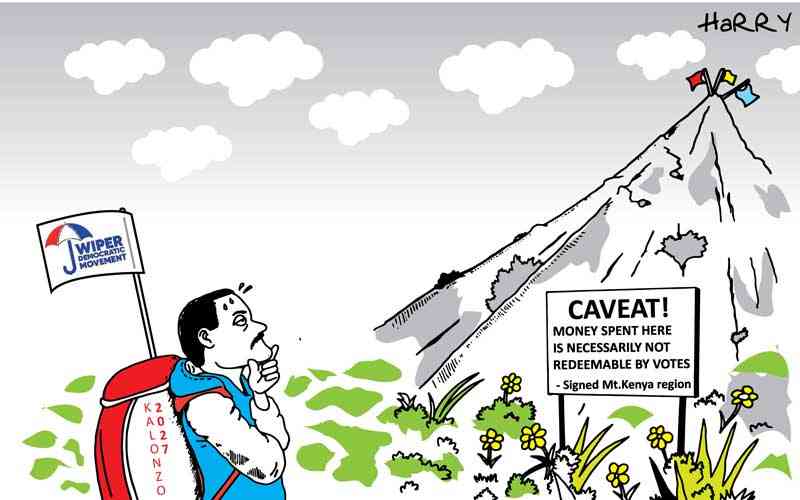Everyone looks toward East Asia for clues to fast economic growth. An export-oriented growth strategy, efficient market system, good education and infrastructure, investor-friendly policies, and even cultural traits have been identified as success factors.
However, the real lesson is perhaps found at a different level. It is useful to compare not just the successes of East Asia with Kenya’s record, but also significantly divergent experiences within East Asia.
The graph below contrasts the growth in per capita GDP (or average income, if you like) of Kenya, Thailand and South Korea. Since 1960, while Kenya’s per capita GDP has doubled, Thailand has raised its average income levels by 11 times, and South Korea by 28.
Thailand accelerated it growth in the 1980s when it started to attract massive foreign investments, particularly from Japan. At the time, the cost of production was rising rapidly in Japan, and many manufacturers were looking for cheaper production sites elsewhere.
The government of Thailand offered generous incentives to court Japanese and other investors. Simultaneously, the country upgraded the basic education system to supply productive workers and improved transport and other infrastructure to support economic growth.
This led to rapid industrialisation, especially in the automotive sector. Manufacturing share in GDP exceeded 30 per cent by 2006, providing many factory jobs with decent pay. Thailand has transformed itself from a largely agrarian country in the 1970s into an industrial powerhouse.
However, this impressive performance pales in comparison with the surge in per capita GDP in South Korea. From the graph, one readily sees there is something qualitatively different in the trajectories of the income growth in these two countries.
In fact, Thailand now struggles with a ‘middle-income trap’; income growth has slowed, because many companies cannot upgrade their products to compete in more high-value segments.
In Thailand, political connections and money influence remain important sources of profit-making. In such an environment, big companies (most of which are family-owned) have little incentives to invest in developing quality products, productivity enhancement and innovation.
Why take such a high risk, when there are easier ways to make money?
Malaysia suffers from the same problem. Both countries rely heavily on foreign technology to move into more advanced industries. They are caught in a model in which the main source of competitiveness is cheap labour. A country cannot become rich by selling cheap labour.
In contrast, South Korea broke with the “rent-seeking” business decisively in the 1960s. President Park Chung-Hee (who came to power in 1961 through a military coup) forced the old-fashioned business houses (“chaebols”) to become internationally competitive manufacturers.
His approach was ruthless; export or perish. A majority of the leading chaebols that existed in 1961 could not keep pace and vanished during his 18-year rule, but the survivors became industrial juggernauts, like Samsung and Hyundai. Corruption never disappeared, but it ceased to be the mainstay of business strategy.
Taiwan and Singapore managed to revamp the fundamental business culture in a similar way and created an environment in which most companies focused singularly on producing competitive and increasingly higher-value products.
All these East Asian countries have invested heavily in education and infrastructure, supported the private sector, promoted exports and strengthened the market system. Yet, some have done spectacularly well and others have struggled to get past the middle-income range.
Stay informed. Subscribe to our newsletter
The most compelling explanation for this difference rests on the idea that the fundamental economic incentive system determines the growth capacity of the country. Where political connections and money influence generate easy profits, the economy stagnates.
An “inclusive” economy, which does not give exclusive privileges to a select few, encourages competition and innovation, and by doing so, sustains vigorous growth. Numerous competitive firms emerge, and create high-skill and high-paying jobs.
This is how some East Asian countries have caught up with wealthy nations. In fact, this is not just an ‘East Asian rule’. No high income countries of today (excluding a few small and extremely oil-rich countries) have achieved their economic status without building an “inclusive economic system.”
From this analysis, two key lessons emerge for Kenya.
First, if Kenya wants to succeed economically, it must overcome the culture of rent-seeking. There are no shortcuts in this matter.
Second, some may say becoming Thailand or Malaysia looks pretty good; most Kenyans might be quite happy with that. However, Thailand and Malaysia benefited immensely from their proximity to Japan and other fast-growing economies of East Asia, both in terms of FDI and trading opportunities.
Kenya’s neighbourhood is very different. Kenya should not hope to follow the ‘Thailand path’ of halfway transformation. It really has no option but to go for sweeping reform.
Of course infrastructure, education and investment climate are all important. But, they cannot substitute for the systemic transformation Kenya needs.
Mr Ohashi is a Senior Economic Advisor to the Presidency of Kenya. Tomorrow: Market is ‘weaponised’ in Kenya. [email protected].
 The Standard Group Plc is a
multi-media organization with investments in media platforms spanning newspaper
print operations, television, radio broadcasting, digital and online services. The
Standard Group is recognized as a leading multi-media house in Kenya with a key
influence in matters of national and international interest.
The Standard Group Plc is a
multi-media organization with investments in media platforms spanning newspaper
print operations, television, radio broadcasting, digital and online services. The
Standard Group is recognized as a leading multi-media house in Kenya with a key
influence in matters of national and international interest.
 The Standard Group Plc is a
multi-media organization with investments in media platforms spanning newspaper
print operations, television, radio broadcasting, digital and online services. The
Standard Group is recognized as a leading multi-media house in Kenya with a key
influence in matters of national and international interest.
The Standard Group Plc is a
multi-media organization with investments in media platforms spanning newspaper
print operations, television, radio broadcasting, digital and online services. The
Standard Group is recognized as a leading multi-media house in Kenya with a key
influence in matters of national and international interest.









